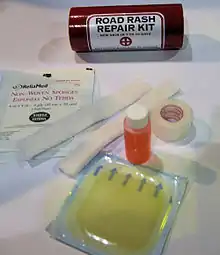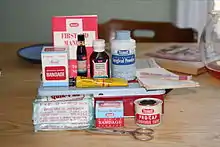Introduction — Issues in Providing Care — Primary Assessment & Basic Life Support — Secondary Assessment — Circulatory Emergencies
Respiratory Emergencies — Soft Tissue Injuries — Bone & Joint Injuries — Environmental Illness & Injury
Medical Conditions & Poisoning — Advanced Topics — Appendices — Meta content
First Aid Kits


Everyone should have a well-stocked first aid kit for in the car, at home, and other events. For first aid kits in the workplace, there will be legislation which specifies what must be present; this will depend on the size and type of the workplace and may vary depending on local, regional, or national regulations. Make sure you know where first aid kits are located, whether at home, at work, or at play. First aid kits should be clearly marked; in the workplace, there should be sufficient indication of the kit's location for those who are unfamiliar with its location to identify it.
First aid kits must be kept well-stocked; supplies do expire, and must be replaced periodically. Consider creating a schedule for checking that the kit is stocked, and replacing any expired items as required. Quantities below are guidelines; you should determine what is required based on the kit's expected use.
If possible use a bright-colored, watertight plastic container. Tool boxes are popular, or it may be worthwhile to purchase a kit made specifically for this purpose.
Recommended Contents
| Item | Home | Car | Wilderness | Workplace (<5 workers)[1] | Workplace (5-15 workers)[1] | Workplace (15-200 workers)[1] | Workplace (>200 workers)[1] |
|---|---|---|---|---|---|---|---|
| Nitrile Gloves (pairs)[2] | 2 | 2 | 10 | 25[3] | 50[3] | 100[3] | 200[3] |
| CPR mask | 1 | 1 | 1 | 1[3] | 1[3] | 1[3] | 1[3] |
| Tape (roll)[4] | 1 | 1 | 2 | 1 | 2 | 4 | 8 |
| 3"x3" sterile gauze pads | 4 | 8 | 20 | 4 | 12 | 48 | 96 |
| 4"x4" sterile gauze pads | 4 | 8 | 20 | 2 | 2 | 10 | 20 |
| Trauma dressing (ABD pad) | 0 | 1 | 2 | 2 | 2 | 6 | 10 |
| Non-stick gauze[5] | 4 | 8 | 20 | 2[3] | 2[3] | 10[3] | 20[3] |
| Roll 2" gauze | 1 | 2 | 5 | 2 | 4 | 8 | |
| Roll 4" gauze | 8 | 16 | |||||
| Adhesive bandages | 20 | 40 | 50 | 12 | 24 | 48 | 100 |
| Antiseptic solution[6] | 1 | 1 | 1 | 1[3] | 1[3] | 1[3] | 1[7] |
| Antibiotic ointment[6] | 1 | 1 | 1 | 1[3] | 1[3] | 1[3] | 1[3] |
| Triangular bandages | 2 | 4 | 4 | 1 | 6 | 12 | 24 |
| Safety pins | 10 | 20 | 20 | 10 | 10 | 20 | 20 |
| Paramedic Scissors | 1 | 1 | 1 | 1[3] | 1[3] | 1[3] | 1 |
| Item | Home | Car | Wilderness | Workplace (<5 workers)[1] | Workplace (5-15 workers)[1] | Workplace (15-200 workers)[1] | Workplace (>200 workers)[1] |
| Tweezers | 1 | 1 | 1[3] | 1[3] | 1[3] | 1[3] | |
| Instant hot & cold packs | 1 of each | 1 of each | 2 of each | 1 of each[3] | 1 of each[3] | 2 of each[3] | |
| First Aid guide[8] | 1 | 1 | 1 | 1 | 1 | 1 | 1 |
| Pen/pencil | 2 | 2 | 2 | 2[3] | 2[3] | 2[3] | 2[3] |
| Paper (or report forms)[9] | 2 | 2 | 10 | 5 | 10 | 20 | 50 |
| Splint[10] | 1 | 2 | 2 | 1[3] | assorted sizes | assorted sizes | |
| Splint padding[11] | 2 | 4 | 4 | 2[3] | 2 | 10 | |
| Waste bag[12] | 1 | 1 | 1 | 1[3] | 1[3] | 1[3] | a biohazard recepticle and/or a sharps container |
| Phone numbers[13] | 1 | 1 | 1 | 1[3] | 1[3] | 1[3] | 1[3] |
| Thermometer | 1 | 1 | |||||
| Sterile saline solution or bottle of water | 1 | 1 | eyewash station[3] | ||||
| Waterproof matches (box) | 1 | 1 | 1 | ||||
| Whistle | 1 | 1 | |||||
| Flashlight (and spare batteries) | 1 | 1 | 1 | ||||
| Penknife | 1 | 1 | |||||
| Certifications[14] | Proof of currency for trained staff | Proof of currency for trained staff | Proof of currency for trained staff | Proof of currency for trained staff | |||
| Log book[15] | 1 | 1 | 1 | 1 | |||
| Item | Home | Car | Wilderness | Workplace (<5 workers)[1] | Workplace (5-15 workers)[1] | Workplace (15-200 workers)[1] | Workplace (>200 workers)[1] |


- 1 2 3 4 5 6 7 8 9 10 11 12 First Aid Requirements, R.R.O. 1990, Reg. 1101 is being used as an example; check the relevant legislation.
- ↑ Using non-latex gloves is important, especially in workplace kits, since you are more likely to be giving treatment to someone who you don't know. Nitrile is always best.
- 1 2 3 4 5 6 7 8 9 10 11 12 13 14 15 16 17 18 19 20 21 22 23 24 25 26 27 28 29 30 31 32 33 34 35 36 37 38 39 40 41 42 43 This is not required, but is recommended
- ↑ Transpore (3M) is great.
- ↑ Look for Telfa; it is the most common variety.
- 1 2 Depending on your location, you may not be legally permitted to use this, except with family members. In that case, eliminate it from workplace kits.
- ↑ This must be ethyl alcohol
- ↑ For workplaces, the legislation may require a certain guide. For example, many Canadian jurisdictions require St. John Ambulance guides.
- ↑ Workplaces should always use pre-made incident report forms. An example form is available. Workplaces are also required to keep these reports on file.
- ↑ Sam Splints are the most versatile and easy-to-use variety. Avoid using splints for specific body parts; the best can be resized to fit arms and legs. Unless you're stocking a kit for a sports team, you're unlikely to require finger splints.
- ↑ If using Sam Splints, splint padding is not required.
- ↑ This will be used to dispose of biohazardous waste, so it must be impermeable to fluids.
- ↑ These should be on a durable card in legible writing or type. You should include EMS numbers as well as poison control, non-emergency ambulance, a cab company, and any emergency contacts (for home kits).
- ↑ Proof of current certification for all on-duty first aiders is often required by law, but is good practice regardless
- ↑ This should log the date of the most recent inspection (and preferably a history of inspections; inspections are to be done at least quarterly) and the signature of the person who did the inspection